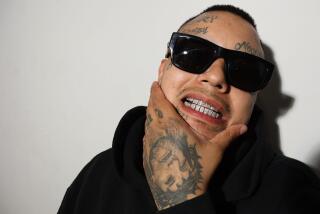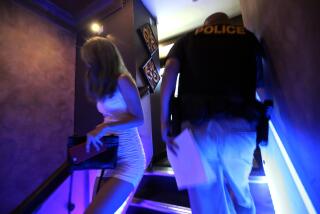51 indicted in Azusa gang’s ‘terrorizing’ of blacks
An Azusa street gang’s campaign against blacks began during a meeting at a local park in 1992.
From there, prosecutors contend, the predominantly Latino street gang went on the attack.
Graffiti with racial epithets began appearing around town, including “Get out N…” sprayed on garage doors of some black residents. Gang members allegedly beat up blacks they found in their “territory,” telling one man “We hate n… in Azusa. This is Azusa.”
Over about 15 years, blacks were assaulted, chased and robbed, their property vandalized, in a “crime spree to drive African Americans out of the city of Azusa,” said U.S. Atty. Andre Birotte Jr.
Authorities announced Tuesday that a federal grand jury had indicted 51 people allegedly associated with the Azusa 13 gang in what prosecutors described as “terrorizing” blacks in the San Gabriel Valley city of more than 48,000.
Azusa Police Chief Robert Garcia said the campaign was partly motivated by racial prejudice. But it also grew from orders by leaders of the Mexican Mafia prison gang to organize Azusa 13’s narcotics business by “eliminating competition so they can have a monopoly on drug sales,” Garcia said. “Usually a street gang member doesn’t get an original idea; it comes from someone higher up.”
According to the indictment, one Azusa 13 member actually drew up a “business plan” aimed at monopolizing drug sales in the city. The plan included taxing drug dealers, protecting those who paid and attacking and destroying the operations of those who did not.
But authorities said the campaign went beyond drug deals to harassment of innocent black residents because of their race.
“We’re brainwashed to think that if we let a black family in, then their [gang] cousins are going to come from Compton,” said one former Azusa gang member who grew up in the neighborhood. He spoke in an interview Tuesday, requesting anonymity out of concern for his safety.
The 24-count indictment is the latest in several prosecutions alleging that Latino gangs in Southern California attacked blacks to get them to move out of neighborhoods the gangs controlled. Many of those incidents occurred in the late 1990s and early 2000s in neighborhoods with histories of gang problems.
A few years ago, federal prosecutors charged members of a Latino gang with a campaign to push blacks out of the unincorporated Florence-Firestone neighborhood that allegedly resulted in 20 homicides over a decade. In the Harbor Gateway district of L.A., a Latino gang was accused of targeting blacks including 14-year-old Cheryl Green, whose death became a rallying point against such attacks. Members of the Avenues, a Latino gang in Highland Park, were convicted of a series of assaults and killings in the early 1990s.
Prosecutors did not allege any racially motivated killings in Azusa. But the indictment describes a climate of fear that the campaign created in a city far from the urban core. Azusa is primarily Latino, with whites making up about a fifth of the population, but blacks account for fewer than 1,500 of the residents.
The indictment provides a detailed look at how the gang ran its drug business and why it decided to target blacks.
Tax revenue collected from drug dealers was sent to a man referred to in the indictment as “Mexican Mafia Member #1,” then incarcerated in Leavenworth, Kan. When he died in 2008, revenue was sent to two other unidentified Mexican Mafia members, the indictment says. The document does not identify “Mexican Mafia member #1,” but a reputed Mexican Mafia member from Azusa, Ruben Rodriguez, was killed in Kansas in 2008 while on parole.
Controlling the neighborhood for the Mexican Mafia members were a series of gang members appointed as “keyholders” — also known as llaveros — who would communicate the prison gang’s bidding to the streets and make sure orders were carried out.
The campaign allegedly began with meetings at Pioneer Park in 1992 in which gang members were urged to get rid of blacks who were then moving into apartments in Azusa.
At one meeting, prosecutors allege, a leader said, “Let’s talk about” blacks. That day, the gang began patrolling the alley by a home where African Americans lived within the gang’s territory. A week later, an unidentified member of the gang tagged “A13,” “AZUSA 13” and a racial epithet on the garage doors of a residential complex to intimidate the African American residents.
As years passed, black residents endured beatings, confrontations, robberies and graffiti from the gang, the indictment says.
In one attack, several gang members surrounded an African American man, holding glass bottles, yelling racial epithets and hitting him in the face. They broke the windows of his car and stole the stereo as he ran to a convenience store to escape, according to the indictment.
Beginning in 1999 the city was struck by a surge in more serious hate crimes as several paroled gang members returned to the streets. Gejuan Salle, a black man and Cedars-Sinai Medical Center nurse, was shot as he was walking outside an auto parts store. In 2000, firebombs were thrown into the homes of three black families one night. Police believe both cases were racially motivated, but they remain unsolved. Attacks continued into 2005.
But by early that decade, Azusa police and community groups had begun to push back. For a brief time, undercover officers even set up a shop called A Peace of Africa, with 24-hour surveillance, selling merchandise from Africa, hoping to entice gang members into attacking it. They didn’t, and the department had to close the store for lack of funds.
Eventually the hate crime investigation led police to arrest six gang members, part of what was known as the “trigger crew.” At one trial, a gang member testifying for the prosecution said Azusa 13 would go out “hunting” blacks in the city. Those gang members were convicted and are serving long prison terms.
The last of them tried, Ralph “Swifty” Flores, was convicted of committing four murders over several years and received the death penalty in 2008.
In recent years, hate crimes in Azusa have dropped to less than one a year, and usually are not gang-related, said Garcia, the police chief.
The gang’s presence has notably diminished. Graffiti is all but gone from the area the gang has claimed since at least the 1960s.
“The indictment is the latest step,” said City Councilman Robert Gonzales. “We have gangs in our city, but we have been able to control and minimize the gang activity compared to the past.”
“We were once classified as the hate crime capital of the region,” added Azusa Mayor Joe Rocha. “Today we are a place of peace and tranquility.”
Los Angeles Times staff writer Abby Sewell contributed to this report.
More to Read
Start your day right
Sign up for Essential California for news, features and recommendations from the L.A. Times and beyond in your inbox six days a week.
You may occasionally receive promotional content from the Los Angeles Times.







